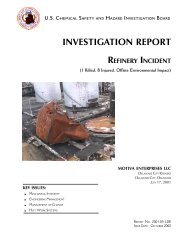CTA Report, Draft 1, ISP Review - US Chemical Safety and Hazard ...
CTA Report, Draft 1, ISP Review - US Chemical Safety and Hazard ...
CTA Report, Draft 1, ISP Review - US Chemical Safety and Hazard ...
Create successful ePaper yourself
Turn your PDF publications into a flip-book with our unique Google optimized e-Paper software.
<strong>CTA</strong> that phenolic resins, when suspended in air, could cause a dust explosion. The letter recommended<br />
precautions such as eliminating ignition sources, <strong>and</strong> using equipment pressure relief <strong>and</strong> damage-limiting<br />
construction. It also listed a telephone contact number for the FM Global engineer, who was described as<br />
“very familiar with the hazards associated with phenolic resin powders <strong>and</strong> recommended safe h<strong>and</strong>ling<br />
practices.” CSB could not verify that <strong>CTA</strong> received the letter. The <strong>CTA</strong> engineering manager listed as<br />
recipient of the letter stated that he had never seen it nor was he aware of its contents.<br />
The Borden <strong>Chemical</strong> account manager for <strong>CTA</strong> routinely discussed phenolic resin issues with <strong>CTA</strong><br />
engineers <strong>and</strong> operating personnel. Written summaries of these meetings reveal that they primarily<br />
covered operational, product quality, <strong>and</strong> health concerns. In 1998, the Borden <strong>Chemical</strong> account<br />
manager reported having discussions with <strong>CTA</strong> personnel about two explosions on line 403 while <strong>CTA</strong><br />
was testing a new formulation of resin.<br />
8.3 <strong>CTA</strong> Awareness of Combustible Dust <strong>Hazard</strong>s<br />
Examination of <strong>CTA</strong> documents showed that at certain times, supervisors <strong>and</strong> managers in the operations,<br />
maintenance, quality control, <strong>and</strong> safety departments; safety committee members; <strong>and</strong> company fire<br />
brigade members discussed the explosive nature of combustible dust. However, this hazard information<br />
was not communicated to the general work force. Interviews with plant personnel revealed widespread<br />
lack of awareness that phenolic resin powders could explode.<br />
Company memor<strong>and</strong>a <strong>and</strong> minutes from safety committee meetings from 1992 through 1995 showed a<br />
concern about creating explosive dust hazards when using compressed air during line cleaning. Use of<br />
grounded air hoses was required, <strong>and</strong> <strong>CTA</strong> explored alternative methods of cleaning. A similar concern<br />
was raised prior to a plant cleaning scheduled during a shutdown in July 1995. In this case, special<br />
precautions were outlined to eliminate ignition points, remove racks, close fire doors, <strong>and</strong> cover motor<br />
control centers. In addition, a 1997 memo from the <strong>CTA</strong> safety director to the operations shift managers<br />
stated: “If airborne dust concentrations become too high…[it] could create an explosion hazard.” Also, a<br />
69









